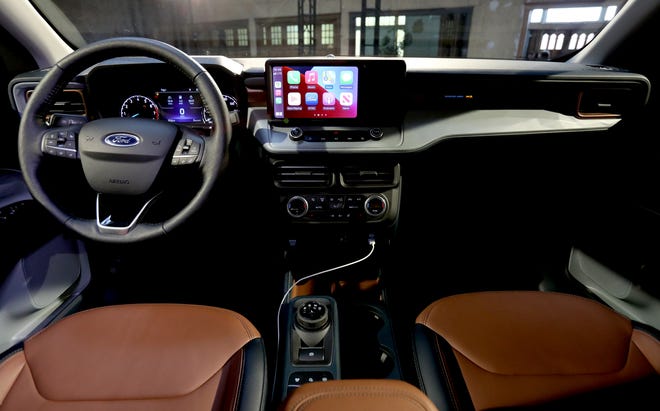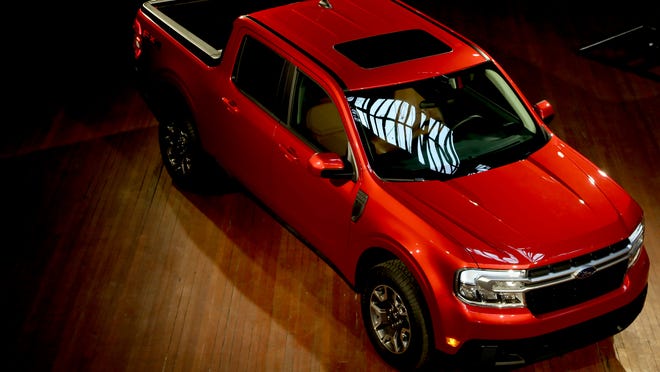Ford bet big on its ability to change Americans’ driving habits with the 2022 Maverick compact pickup Tuesday. Attractively priced, with a 40-mpg hybrid starting at $19,995 and going on sale this fall, the Maverick is intended to get a whole new class of customers into pickups, marketing boss Trevor Scott told me in an interview.
“We fully expect to put the Maverick on the map with customers who haven’t previously considered pickups,” Scott said. “We expect a large number of first-time pickup buyers” who previously drove small sedans and SUVs, Scott said. “Our target customers have had to compromise fuel efficiency versus cargo or passenger space.”
The Maverick’s 100.3 cubic feet of passenger space is considerably more than Ford’s discontinued Fiesta and Focus small cars, and nearly as much as the defunct midsize Fusion sedan, which cost thousands of dollars more than the Maverick’s base price. Its 54.4-inch long bed dwarfs those cars’ cargo capacity, while a fold-up rear seat offers big-box space protected from the elements and pilferage.

2022 Maverick highlights
Four-door, five-passenger cabin, with plenty of storage
191-horsepower hybrid base model rated 40-mpg in EPA city driving tests
Optional 250-hp model
Front- or all-wheel drive
54.4-inch long bed
Standard automatic high beams
Standard automatic emergency front braking
2,000- or 4,000-pound towing capacity, depending on FWD or AWD drivetrain
1,500-pound payload
What could go wrong? Ask Subaru
Despite the Maverick’s appealing price and features, skepticism is merited, if not mandatory. Without getting too deep in the engineering weeds, previous small pickups built on car-type chassis like the Maverick uses have consistently flopped in the U.S. Pickups are fabulously popular and profitable here, but buyers spurned little trucks that strayed from the body-on-frame construction of Ford’s Ranger midsize and F-series full-size pickups.
The history of failure includes the Subaru Brat in the 1970s, VW Rabbit pickup in the ’80s and Subaru’s second bite of the apple with the Baja in the 2000s. Even the Honda Ridgeline, bigger and better equipped than that trio and backed by Honda’s enviable reputation, has sold slowly here, with just 32,168 sales in 2020 and 33,334 in pre-pandemic 2019.
Ford expects to sell considerably more Mavericks than that. The compact pickup is one of the “white space” vehicles the automaker counts on to offset sales lost when it dropped the Fiesta, Focus and Fusion.
“Who better than Ford, with our credibility and heritage building pickups” to convince new customers to try a truck, Scott asked.

More: Ford Maverick faces challenges, potential big payoff
More: 2022 Hyundai Santa Cruz offers small size, striking looks
Standard safety and assist features include:
- Auto high beams
- Automatic headlights
- Pedestrian detection and braking
- Front collision alert and braking
Optional safety and assist features include:
- Adaptive cruise control
- Evasive steering assist
- Lane centering
- Reverse sensing
- Blind spot and cross-traffic alert
- Lane departure alert and assist
- Hill descent control
Developed fast, with an eye on buyers’ budgets
Ford engineers took nearly two years out of the company’s usual timeline developing the Maverick, keeping an eye on costs the whole time.
The interior is thrifty, with what Ford calls “speckled” plastic surfaces rather than cushioned materials on the dash and door.
The seats are cloth or vinyl — no option for leather — and the 8-inch touch screen is small by the standards of new vehicles. Ford created new shorter inner door handles to make more room for bottles, laptops and the like in storage pockets. It remains to be seen whether those decisions led to less comfortable grips to pull the door closed or surfaces to rest your arm.
Even Ford’s aging Sync3 infotainment system is an option, though Apple CarPlay and Android Auto are standard.
Ford is betting Maverick owners won’t notice or care. The Maverick isn’t intended to compete with niceties like 10-inch touch screens and padded surfaces in bigger pickups. It’s Ford’s entry-level model, designed to take on vehicles like the Hyundai Venue, Nissan Kicks — no all-wheel drive there — and small cars like the Toyota Corolla and Honda Civic with less room and worse visibility.
The Maverick shares its basic engineering with the Ford Escape, Bronco Sport and Lincoln Corsair compact SUVs. It’ll be built alongside the Bronco Sport in Hermosillo, Mexico.
The Maverick’s key advantages include an easy to park 199.7-inch length — you can fit in a standard street side spot and have room to open the tailgate! — and a low height that makes it easy to step into the cabin and even reach over the side and into the bed. Try that in your ChevFoRamToyoNiss full-size pickup, or even a midsize Honda Ridgeline.
The Maverick is a bit bigger than the sleek Santa Cruz compact Hyundai will introduce this fall. Its styling is much more purposeful, with a general-issue Ford grille, C-clamp head and taillights and tailgate.
Ford will make the Maverick in three trim levels: XL, XLT and Lariat.
Prices and fuel economy estimates for the full model line will be available closer to the start of sales.
2022 Ford Maverick at a glance
Five-passenger front- or all-wheel drive compact pickup
On sale this fall
Base price: $19,995 (excluding destination charges)
Base drivetrain: Front-wheel drive hybrid 191 hp total system power and continuously variable automatic transmission
Optional drivetrain: Front- or all-wheel drive 2.0L turbocharged 4-cylinder producing 250 hp at 5,500 rpm and 277 pound-feet of torque at 3,000 rpm. Eight-speed automatic transmission.
Wheelbase: 121.1 inches
Length: 199.7 inches
Width: 77.9 inches (mirrors folded)
Height: 68.7 inches
Bed length: 54.4 inches
Bed width at wheel house: 42.6 inches
Passenger volume: 100.3 cubic feet
Cargo volume: 33.3 cubic feet
Towing: Base model, 2,000 pounds; 2.0L, 4,000
Payload: 1,500 pounds
Assembly location: Hermosillo, Mexico
